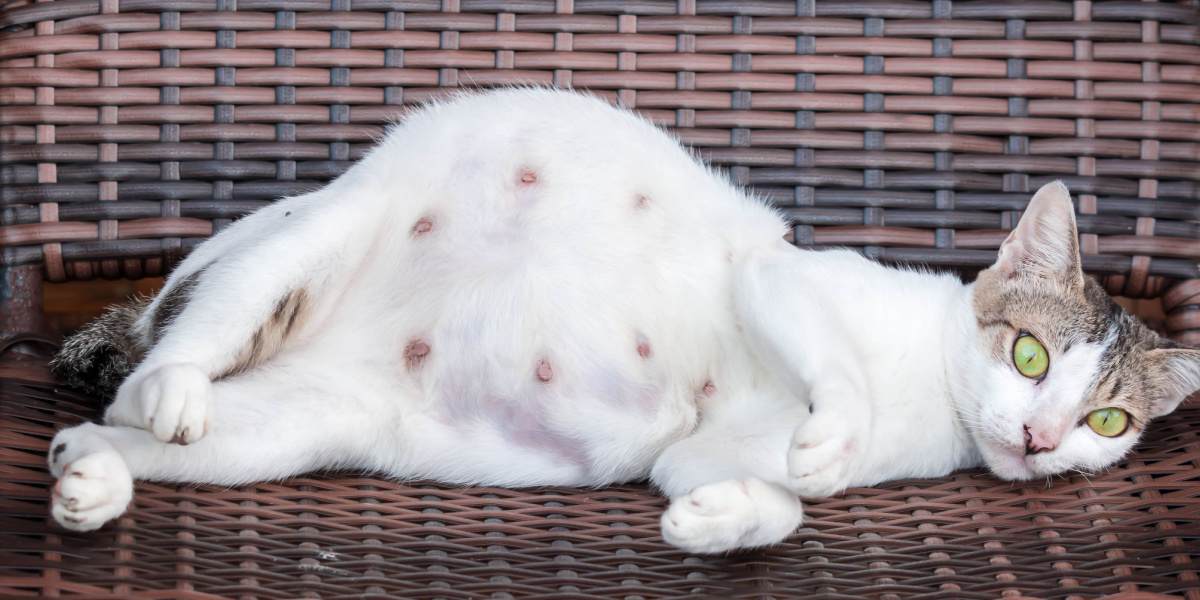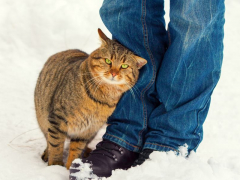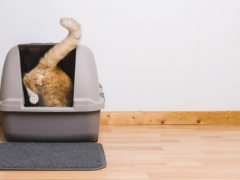
If you have ever been pregnant or known a pregnant person, you are probably familiar with the urge to “nest” or prepare the home for that new arrival. However, did you know this nesting instinct is also true of cat behavior? In this article, we will consider what’s normal when it comes to pregnancy and labor in cats, including everything you need to know about nesting behavior.
Nesting behavior is your cat's way of creating a safe place to give birth to her kittens. You can offer your cat a nesting box, but she might prefer to find her own space. Contact your emergency veterinarian if your spayed female cat is displaying nesting behavior as it could indicate a medical problem.Key Takeaways
What Is Normal in Feline Heat Cycles?
Unspayed female cats can get pregnant from around 4 months of age. Importantly, they can become pregnant by mating with a sibling, so always consider neutering opposite-sex siblings when kept together.
Cats are polyoestrus, meaning they cycle multiple times during the breeding season. The time of year female cats start a heat cycle, or oestrus cycle, depends on geography and daylight hours. Cats in the Northern Hemisphere typically cycle from January to fall, but some indoor cats or those in tropical climates may cycle all year round.
The average oestrus cycle length is around three weeks; this can vary hugely. Your cat may become pregnant at any time during her cycle.
Signs of oestrus include:
- Increased affection
- Calling
- Rolling on the floor
- Raising bum in the air when stroked (called lordosis)
- Increased urination or urine spraying
- Male cats appearing in the yard
Female cats can be so insistent with these behaviors that they become frustrating to many pet parents.
What Is Normal in Feline Pregnancy?

Cats are pregnant for about two months before delivering their kittens.
The average feline gestation period is 63 days. Some cats will carry their kittens for a few days longer, so a normal range is considered to be 63 to 65 days, just a little over two months. Some cats will give birth as early as 58 days, while others may carry for 68 days. Signs of pregnancy include:
- Weight gain
- Rounding or swelling of the belly
- Increased appetite
- Change in nipple appearance
- Behavioral changes (such as increased affection)
- Nesting behavior
If your intact female cat shows some of these signs, she may be pregnant. Your veterinarian will be able to confirm this via ultrasound or x-rays. Your veterinarian will also advise you on nutrition and preventive health care for your pregnant cat, both of which are vital to get right.
What Is Nesting Behavior?
Nesting behavior is the drive a mother animal experiences to prepare an environment for their new arrivals. It derives from the natural instinct of your cat’s wild counterparts to protect their kittens from predators.
Nesting is driven by the action of several hormones, including estradiol, progesterone, and prolactin. In cats, nesting behavior usually presents as your cat finding a dark, warm, and safe space, such as the back of a wardrobe or under the bed. She may also carry clothing or fabric to this nest.
Some pet parents provide their cats with a nesting box. This doesn’t have to be fancy, and a simple cardboard box lined with towels is sufficient. Do not be offended if your cat chooses not to use your nesting box. Don’t try to force her to use it as this may make her more stressed.
Why Do Domestic Cats Nest?
If you are seeing nesting behavior in your entire female cat, she is likely pregnant and may go into labor within the next week or so. You will probably have noticed other signs detailed above, but sometimes it can be unclear.
This is especially true if your cat only carries a single kitten; she may not have gained that much weight or have a swollen belly. Nesting is your cat’s way of creating a safe space and comfortable place for her to raise her kittens.
If your cat has been spayed and is showing nesting behavior, it is advisable to speak to your veterinarian. This may be a sign of a hormonal imbalance or could mean she has an “ovarian remnant.” These conditions can put her more at risk of developing a uterine infection, or pyometra, in the small portion of her uterus that remains after surgery.
Also Read: Cat Uterus Infection (Pyometra): Causes, Symptoms, & Treatment
What Makes the Ideal Nest for My Cat?
If your cat is pregnant, you will likely wish to help her in any way possible. If you provide her with a nesting box, ensure you place it somewhere dark and quiet. This will make her feel safe and secure. It is important to choose somewhere that is draft free. In the early days, newborn kittens cannot regulate their body temperature, and if they are in a drafty spot, they can quickly become cold or may even die.
Line your nesting box with old towels or clothes. Cats tend to be very clean when they labor, but a bit of fluid is to be expected, and you may wish to throw away the bedding afterward.
It can be helpful to bring your cat’s resources into the same room as her nest (her food and water bowls and litter tray). In those early days, she may be reluctant to leave her kittens, and it can help to have what she needs close by.
How Can I Tell My Cat Is in Labor?

A cat in labor might display certain behaviors such as restlessness, panting, or hiding.
As your cat gets ready to have her kittens, her birth canal will begin to relax and widen. This stage usually lasts around six to 12 hours, and you may see some behavioral changes, including restlessness, panting, or hiding away.
As her active labor approaches, she will likely settle down into her nesting box or hideaway. There is a small subset of cats, however, that will choose to seek out their pet parent for comfort during active labor.
What Is Normal for a Cat in Labor?
In cats, normal labor occurs in three stages:
1. First Stage Labor
During this time, the cervix and pelvic muscles relax while the uterus begins to contract. Discharge from the vagina is rare. Your cat may go off her food and make repeat trips to her nest. If this is her first litter, this may last up to 36 hours.
2. Second Stage Labor
At this point, the uterine contractions ramp up. The water bag around the kitten will rupture. In this stage, your cat will bare down and push out the kitten. Usually, this stage takes between five and 30 minutes.
3. Third Stage Labor
This is where the fetal membranes and placenta are passed. Usually, this happens after each kitten, but sometimes it may be delayed if the second kitten arrives quickly. The mother will generally eat the afterbirth, so you may not see these unless you are watching. The typical interval between kittens is around 10 minutes to an hour.
Occasionally cats will have an interrupted labor, where they pause between kittens to rest. This can last up to 24 to 36 hours and can be expected. Please call your veterinarian if you are unsure about your cat’s labor.
When Should I Call My Veterinarian?

If something seems wrong while your cat is in labor, do not hesitate to call your veterinarian for advice.
Cats generally can labor and give birth readily without intervention, but sometimes things do go wrong. It is advisable to keep an eye on your cat while she has her babies and call your veterinarian if you notice any of the following:
- Excessive bleeding
- Green discharge from your cat’s vulva/rear end
- Any signs of distress
- Unproductive straining
- Signs of exhaustion
- A kitten becomes stuck
Call your emergency veterinary provider immediately if you are worried something is wrong at any stage in your cat’s labor. Cesarean sections are unusual for cats, but they are not unheard of. Prompt veterinary intervention increases the likelihood of a successful outcome. If your cat shows signs of pregnancy after being spayed, it is also essential to speak to your veterinarian.
Also Read: Early-Age Spaying & Neutering Of Cats
Final Thoughts
Nesting behavior is your cat’s way of creating a safe environment for her kittens. Therefore, if you’ve noticed your entire female cat has started to show nesting behavior, congratulations, as it may be time to ready yourself for some sweet new arrivals! However, if this comes as a surprise, you need extra support, or your cat is spayed, then reach out to your veterinarian for advice.
Frequently Asked Questions
Why is my female cat nesting?
If your female cat is intact and showing nesting behavior, it may mean she is pregnant. If your cat has been spayed but is showing nesting behaviors, it may indicate a hormonal disorder. In either case, you should speak to your veterinarian for advice.
How long after my cat starts nesting will she give birth?
Nesting behavior can be seen at any point in the last week of pregnancy in cats. Therefore, your cat may have her kittens imminently, or you may have to wait a few days before you meet them.
Should I stay with my cat while she gives birth?
There is no simple answer to this question. Some cats will seek out their owner during labor for comfort. However, the majority will choose to labor somewhere quiet and safe, alone. Be guided by your cat and respect her boundaries if she decides to hide away while she has her babies.
How many months is a cat pregnant?
The average gestation period for a cat is 63 days, although some cats will carry their kittens for a few days longer. This equates to just over two months.
-
Holst. B (2022) Feline Breeding and Pregnancy Management: What is normal and when to intervene. Journal of Feline Medicine and Surgery. 24 221-231. DOI https://doi.org/10.1177/1098612X221079708 [Retrieved 5th September 2022]
-
Jennet. A et al. (2015) Evidence for seasonal reproduction in UK domestic cats. Journal of Feline Medicine and Surgery. 18:10 804-808. DOI https://doi.org/10.1177/1098612X15595665 [Retreieved 5th September 2022]
-
Johnson. A (2022) Normal feline reproduction; The queen. Journal of Feline Medicine and Surgery. 24:3 204-211. DOI https://doi.org/10.1177/1098612X221079706 [Retrieved 5th September 2022]







